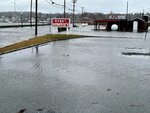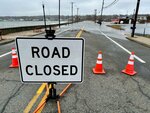- WEDNESDAY, JULY 17, 2024
Portsmouth: When the ‘big one’ comes, will you be ready?
Island Park/Hummocks mobilize to prepare for busy hurricane season — but more volunteers needed
PORTSMOUTH — John Vitkevich stood on Teddi’s Beach on the north end of Park Avenue Tuesday, pointing to the open Atlantic Ocean.
“We’re standing in one of the most …
This item is available in full to subscribers.
Please log in to continue |
Register to post eventsIf you'd like to post an event to our calendar, you can create a free account by clicking here. Note that free accounts do not have access to our subscriber-only content. |
Day pass subscribers
Are you a day pass subscriber who needs to log in? Click here to continue.
Portsmouth: When the ‘big one’ comes, will you be ready?
Island Park/Hummocks mobilize to prepare for busy hurricane season — but more volunteers needed

PORTSMOUTH — John Vitkevich stood on Teddi’s Beach on the north end of Park Avenue Tuesday, pointing to the open Atlantic Ocean.
“We’re standing in one of the most vulnerable spots in Island Park,” he said as he motioned to the dilapidated state of the Stone Bridge abutment, which for years helped protect residents, boats and the shoreline before yet another storm severely damaged part of it in 2019.
The time is now, he said. According to the National Oceanic and Atmospheric Administration (NOAA), this year’s hurricane season may be the busiest ever. NOAA says there’s an 85-percent chance of the 2024 Atlantic hurricane season, which spans from June 1 to Nov. 30, to be “above normal” and only a 5-percent chance of it being “below normal.”
The public can’t wait until a major storm arrives, said Vitkevich. “When it gets here, it’s too late,” he said. “Island Park, as low-lying as it is, is vulnerable.”
For an area so uniquely at risk in the event of a major storm, though, Island Park has been slightly behind the eight ball compared to other neighborhoods in Portsmouth.
“We have a great Common Fence Point (CFP) Preparedness Committee. We have one on Prudence Island; I didn’t know about that,” said Vitkevich.
The volunteer CFP group was formed in 2019 and has been active in its efforts to keep the low-lying neighborhood prepared for and resilient to hazards such as flooding from intense storms and extreme tides, as well as from the long-term impacts of climate change such as rising sea levels, and the erosions of the coastline. The CFP group’s next meeting is scheduled for 6:30 p.m. on Wednesday, Aug. 7.
The Island Park and Hummocks Preparedness Committee is ramping up efforts to get the two neighborhoods more involved, however. The group will meet at 6 p.m. on Thursday, July 25, in the Portsmouth Room located on the second floor of Town Hall.
The group has met several times, but has attracted only seven to 10 people for each gathering, Vitkevich said. “We hope to get more bodies in there,” he said. “I’d like to see 25, 30 people involved,” each of them with different tasks.
One of the major goals of each preparedness committee is to coordinate efforts with Ray Perry, director of the town’s Emergency Management Agency (EMA).
“We want to assign positions so that when we get the call, we can work with Ray Perry and make sure we’re in place,” Vitkevich said. “Being prepared is the most important thing Island Park and the Hummocks can do this year. If we get through this year, great. We’ll continue to meet during the wintertime to formulate a plan for next year. I don’t think this threat is ever going to go away.”
Unique concerns
On Tuesday, Perry said each area of Portsmouth has its own unique concerns when it comes to hurricane preparedness, and that’s why there are different committees. The Prudence Island group, for example, doesn’t have as much of a focus on mitigation compared to Common Fence Point.
“(Prudence Island) is looking at hurricane evacuation, and fires are really big with them,” Perry said. “Island park seems to be a little more response-oriented now. There are also some mitigation things they’ll be focused on, too. We’re updating our (regional) hazard mitigation plan and already Island Park has weighed in on that as a neighborhood. It has a lot of more weight when they speak as a neighborhood.”
He also said Island Park’s demographics are different. “You’re got a more diverse type of community in Island Park and I noticed during COVID that there are individuals that might need some assistance,” he said.
That’s why it’s important to keep a neighborhood connected in the event of a big storm or other emergency. To that end, the preparedness committees are learning about a new tool, an app called Map Your Neighborhood, which is designed to improve readiness at the neighborhood level. The app will be one of the points of discussion at next week’s CFP/Hummocks meeting.
“We haven’t done it before,” said Perry. “It’s a program that came out of Seattle and it’s really successful. It links into our town’s GIS (geographic information system) and maps out the assets in the community — not just infrastructure. Is there a nurse here, is there a doctor? Are there seniors who need extra help?”
The app also maps out pickup points and assigns “block captains” who notify people in need.
“Everybody’s got to have a position of what to do,” Vitkevich added. “We can’t rely on the police and fire departments to help us out once it gets here.”
Another app, called Crisis Track, is rolling out statewide, according to Perry. The app helps identify disaster cost and complete paperwork to the Federal Emergency Management Agency (FEMA) in order to receive faster disaster assistance.
Residents would use the app to input before-and-after, time-dated photographs and other information whenever a big storm hits. “Then you have proof that damage was done to your property for federal assistance,” Perry said. “We’re still in the process of implementing it and training people to use it.”
Dealing with deniers
When asked what he says to those residents who still believe climate change is a hoax, Vitkevich let out an expletive before pointing to the changes he’s seen over the years.
“I was born in 1953. I’ve watched weather patterns change. The world is changing. We’re putting more fossil fuels into the air. Solar is not going to make a dent on global warming. Wind? We’re just not there yet to negate what we’re doing,” he said.
Climate experts all over the world are not making it up, he said. “The scientists are not politicians; they’re not lying. I’ve seen evidence of it at my house in the 36 years I’ve lived there. I know when I look at Spectacle Island and I see the white birch. This year they were budding earlier — that new green was much earlier than ever before,” he said.
Perry is more diplomatic in his response to climate change deniers. “I’m sorry they believe that. We have to go by the science and data that’s out there,” he said. “I live in Island Park and I see Park Avenue flood more and more. I have the sense that people are coming around on it because they see the threat.”
However one feels about climate’s longterm impacts, Vitkevich said it’s vital to connect residents from the most vulnerable areas in town to formulate a plan before every major storm.
“When Mother Nature throws a hurricane at us, I want to be prepared,” he said.
EMA Director Ray Perry reminds Portsmouth residents that although there are concentrated efforts happening in the more vulnerable areas of town, he’s always happy to make a presentation on evacuation or preparedness issues to any neighborhood. You can reach him at 401/477-2172 (preferred) or 401/643-0350.
Keywords
Island Park, Hummocks, Common Fence Point, Prudence Island, hurricane, hurricane preparedness, resiliencyOther items that may interest you

















